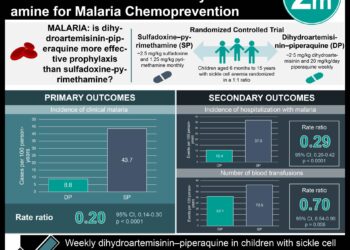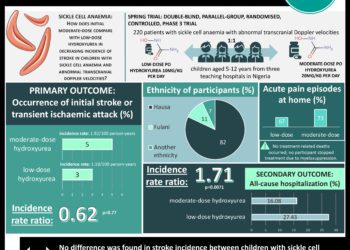Hematopoietic stem cell transplantation reduces transcranial doppler velocities in children with sickle cell anemia
1. In this nonrandomized controlled intervention study, matched sibling donor stem cell transplantation (MSD-HSCT) was associated with lower transcranial doppler velocities (TCDs) at 1 year compared to chronic transfusions.
2. MSD-HSCT was also associated with changes in highest TCDs at 3 years, normalization rate at 1 year, and ferritin levels at 1 and 3 years.
Evidence Rating Level: 1 (Excellent)
Study Rundown: Increased transcranial doppler velocity (TCD) in children with sickle cell anemia (SCA) is associated with an increased risk of ischemic stroke, stenosis, and silent cerebral infarcts. Previous studies have identified the pivotal role of chronic transfusions in reducing stroke risk, while newer studies have considered other preventive approaches such as hydroxyurea or matched sibling donor stem cell transplantation (MSD-HSCT). In this randomized control trial, children with SCA who received MSD-HSCT had lower TCDs at 1 and 3 years compared to those receiving care as usual (chronic transfusions). MSD-HSCT also led to greater normalization rates at 1 year and lower ferritin levels at 1 year and 3 years.
Overall, this study shows that children with SCA that receive MSD-HSCT have significantly lower TCDs at 1 year. The study is limited by its use of a short-term endpoints (cerebral velocities at 1 year), non-randomized design, and relatively small sample size. Further research is required to assess the effects of MSD-HSCT on clinical outcomes.
Click to read the study in JAMA
Relevant Reading: Hematopoietic stem cell transplantation for sickle cell disease: Progress and challenges
In-Depth [prospective cohort]: The DREPAGREFFE study is a nonrandomized, controlled, open-label intervention study that was conducted at 9 sites in France. A total of 67 children were enrolled with 32 assigned to the transplantation group and 35 to the standard care group. Study visits were completed at baseline, 1 year, and at 3 years. Primary outcome consisted of time-averaged mean of maximum velocities (TAMV) without angle correction in the 8 cerebral arteries at 1 year. There was a total of 29 secondary outcomes utilized in the study that included highest TAMV at 1 and 3 years, incidence of ischemic stroke, survival without ischemic stroke, as well as several others. In the transplantation group, highest TCDs were significantly lower on average at 1 year (129.6 cm/s vs 170.4 cm/s; p < 0.001). Similarly, highest TCDs at 3 years were lower in the transplantation group (112.4 cm/s in transplantation group vs 156.7 cm/s in standard of care; p = 0.001). Normalization at 1 year was higher in the transplantation group (80.0% in transplantation group vs 48.0% in standard of care; p < 0.05). Ferritin levels were lower in the transplantation group at 1 year (905 ng/mL in transplantation group vs 2529 ng/mL in standard of care group; p < 0.05) and 3 years (382 ng/mL in transplantation group vs 2170 ng/mL in standard of care group; p < 0.05).
Image: PD
©2019 2 Minute Medicine, Inc. All rights reserved. No works may be reproduced without expressed written consent from 2 Minute Medicine, Inc. Inquire about licensing here. No article should be construed as medical advice and is not intended as such by the authors or by 2 Minute Medicine, Inc.







